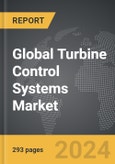Turbine control systems are critical for the optimal operation and safety of turbines used in power generation and industrial applications. These systems ensure the precise regulation of turbine speed, temperature, pressure, and other operational parameters, thereby enhancing efficiency and preventing mechanical failures. Modern turbine control systems integrate advanced algorithms and digital controls that enable real-time monitoring and adaptive adjustments, ensuring seamless operation under varying load conditions. The importance of these systems is further underscored in high-stakes environments like nuclear and hydroelectric power plants, where reliability and precision are paramount.
What Technological Innovations Are Shaping Turbine Control Systems?
Technological advancements have revolutionized turbine control systems, with significant improvements in sensors, automation, and digitalization. The integration of IoT and advanced control algorithms allows for predictive maintenance and real-time diagnostics, minimizing downtime and operational costs. Developments in artificial intelligence and machine learning enable these systems to predict performance issues and optimize operational parameters dynamically. Furthermore, advancements in cybersecurity are crucial for protecting these critical systems from potential cyber threats, ensuring uninterrupted operation and data integrity. The transition towards renewable energy sources has also spurred innovations in control systems designed specifically for wind and solar turbines.Why Is There an Increase in Adoption Across Various Sectors?
The adoption of turbine control systems is rising across multiple sectors, including power generation, oil and gas, and manufacturing. In the power generation sector, these systems are indispensable for the efficient operation of thermal, hydroelectric, and wind turbines. The oil and gas industry relies on them to control turbines used in various extraction and processing operations, ensuring safety and efficiency. In the manufacturing sector, turbines used for power and mechanical drives benefit from enhanced performance and reliability provided by advanced control systems. The global shift towards renewable energy and the need for energy efficiency in industrial processes are major drivers of increased adoption.What Are the Key Growth Drivers in the Turbine Control Systems Market?
The growth in the turbine control systems market is driven by several factors. The increasing demand for energy and the expansion of power generation infrastructure, particularly in developing countries, are major contributors. Stringent regulations regarding emissions and energy efficiency necessitate the adoption of advanced control systems to ensure compliance. The transition towards renewable energy sources and the corresponding need for sophisticated control mechanisms also drive market growth. Technological advancements that enhance system reliability, efficiency, and integration with digital platforms further boost the adoption of turbine control systems. Additionally, the rising awareness of the benefits of predictive maintenance and the need for operational cost reduction are significant growth drivers in this market.Key Insights:
- Market Growth: Understand the significant growth trajectory of the Controllers Component segment, which is expected to reach US$8.1 Billion by 2030 with a CAGR of a 5.8%. The Sensors Component segment is also set to grow at 4.9% CAGR over the analysis period.
- Regional Analysis: Gain insights into the U.S. market, which was estimated at $4.7 Billion in 2023, and China, forecasted to grow at an impressive 7.6% CAGR to reach $5.2 Billion by 2030. Discover growth trends in other key regions, including Japan, Canada, Germany, and the Asia-Pacific.
Why You Should Buy This Report:
- Detailed Market Analysis: Access a thorough analysis of the Global Turbine Control Systems Market, covering all major geographic regions and market segments.
- Competitive Insights: Get an overview of the competitive landscape, including the market presence of major players across different geographies.
- Future Trends and Drivers: Understand the key trends and drivers shaping the future of the Global Turbine Control Systems Market.
- Actionable Insights: Benefit from actionable insights that can help you identify new revenue opportunities and make strategic business decisions.
Key Questions Answered:
- How is the Global Turbine Control Systems Market expected to evolve by 2030?
- What are the main drivers and restraints affecting the market?
- Which market segments will grow the most over the forecast period?
- How will market shares for different regions and segments change by 2030?
- Who are the leading players in the market, and what are their prospects?
Report Features:
- Comprehensive Market Data: Independent analysis of annual sales and market forecasts in US$ Million from 2023 to 2030.
- In-Depth Regional Analysis: Detailed insights into key markets, including the U.S., China, Japan, Canada, Europe, Asia-Pacific, Latin America, Middle East, and Africa.
- Company Profiles: Coverage of major players such as ABB Ltd., American Superconductor Corporation, Compressor Controls Corporation, and more.
- Complimentary Updates: Receive free report updates for one year to keep you informed of the latest market developments.
Select Competitors (Total 43 Featured):
- ABB Ltd.
- American Superconductor Corporation
- Compressor Controls Corporation
- Emersion Electric Co.
- General Electric Company
- HEINZMANN GmbH & Co. KG
- Honeywell Process Solutions
- HPi LLC
- Kawasaki Heavy Industries, Ltd.
- Mita-Teknik
- Rockwell Automation, Inc.
- Rolls-Royce Holdings PLC
- Siemens AG
- Woodward, Inc.
Table of Contents
Companies Mentioned
- ABB Ltd.
- American Superconductor Corporation
- Compressor Controls Corporation
- Emersion Electric Co.
- General Electric Company
- HEINZMANN GmbH & Co. KG
- Honeywell Process Solutions
- HPi LLC
- Kawasaki Heavy Industries, Ltd.
- Mita-Teknik
- Rockwell Automation, Inc.
- Rolls-Royce Holdings PLC
- Siemens AG
- Woodward, Inc.
Table Information
| Report Attribute | Details |
|---|---|
| No. of Pages | 293 |
| Published | December 2024 |
| Forecast Period | 2023 - 2030 |
| Estimated Market Value ( USD | $ 17.6 Billion |
| Forecasted Market Value ( USD | $ 24.2 Billion |
| Compound Annual Growth Rate | 4.6% |
| Regions Covered | Global |
| No. of Companies Mentioned | 14 |









